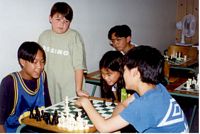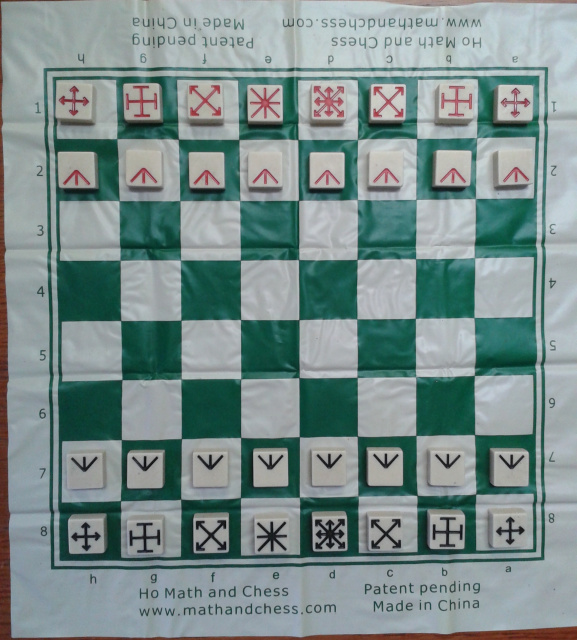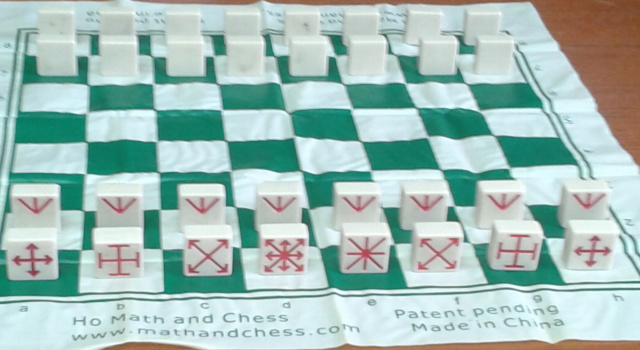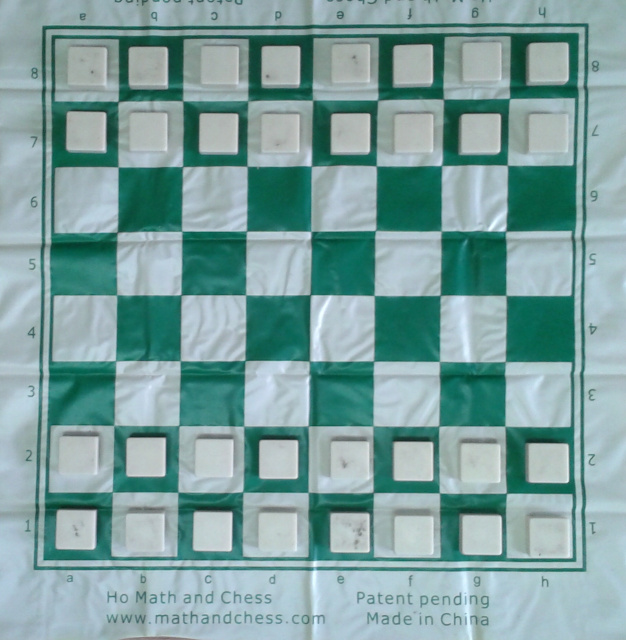
Ho Math Chess™ Teaching Set
Purchase information:
If you are in Vancouver, Canada: $15 per complete set including board, and all pieces in a pocket-sized box.
All other areas: $15 plus shipping per complete set including board, and all pieces in a pocket-sized box.
|
 Regular chess Regular chess
|
 Half-blind chess Half-blind chess
|
 Blind chess Blind chess
|
December 11, 2007, was the date that the world's first flat-surfaced, all-squared, uniform look chess teacher set was available to the world. This chess teacher set has become a collector's item since not only it is the world's first, it creates a new dimension on how math can be taught by combining chess and math through Frankho Geometry Chess Symbols (Trademark Canada TMA771400).
The theoretical background on this chess set was published in Vector (Fall 2007, Volume 48, Issue 3), the Official Journal of the British Columbia Association of Mathematics Teachers in Canada.
One-of-its-kind and unique Ho Math Chess Teaching Set is sold worldwide and carries Ho Math Chess reputable brand name. This Ho Math Chess teaching set is "out-of-this-world", a genius invention by using Frankho Geometry Chess Symbols (copyright and trademark applied).
Details on the chess set, click HERE.
- To view Mr. Frank Ho teaching 4/5 years old children chess using Ho Math Chess Teaching Set. Click HERE.
- Click HERE for a demo on playing blind chess.
- Click HERE for a demo on how to play a handicapped chess game without removing any chess pieces.
- Click HERE for a demo on playing puzzle # 1 (Arrange 8 pawns puzzle.)
- Click HERE for a demo on playing puzzle # 2 (16 pieces pile-up world record by a grade 1 girl in Canada)
- Click HERE for a demo on playing puzzle # 3 (whoever falls first loses the game.)
- Click HERE for a demo on playing puzzle # 4 (22 pieces pile-up world record by a grade 9 girl in Canada.)
- Click HERE for a demo on playing puzzle # 5 (turn rhombus into the triangle by moving 2 pieces.)
- Click HERE for a demo on playing puzzle # 6 (turn the rectangle into a right triangle by moving 3 pieces.)
- Click HERE for a demo on playing puzzle # 7 (turn 3 x 3 square into 4 x 4 square by moving 4 pieces.)
- Click HERE for a demo on playing puzzle # 8 (2 knights exchange, part 1 of 2)
- Click HERE for a demo on playing puzzle # 9 ((2 knights exchange, part 2 of 2)
- Click HERE for a demo on playing puzzle # 10 (Flip triangle.)
Ho Math Chess Teaching Set
How to play?
Since how each chess piece should move is marked symbolically on the surface of each chess piece using the idea of symmetry of a square and geometric concept of arrow and line segment, so the description on how to play is exactly the same as the "traditional" chess set but much clearer.
The rook moves up/down and left/right with no number of squares restricted, so it has arrows showing it can go/down and left/right.
Bishop moves diagonally, so it has arrows showing the number of squares that can be reached is only limited by its chessboard.
The same idea applies to the queen with all 8 arrows in 8 directions showing the number of squares can be reached is only limited by its chessboard, but the king has no arrows, so its movement is limited to only one square for each move.
The pawn can move forward but captures in a diagonal way so its moves are showing no arrows (I.e., can not move with an unlimited number of squares).
Knight has the shape of 8 L directions but no arrows so it can "jump" to only one directed square by a line segment in L shape.
- A chess teacher chess set 
- Specially designed for children as young as 4-year old to learn chess easily.
- Multi-function capabilities for playing traditional chess games and also blind or half-blind games to improve memory.
- It can be used to play puzzles, not just chess.
- Looking for something unique? Your wish has come true!
- Cute, pocket-sized chess set for easy carrying. Children love it!
- What you see is what you move! Sooooo easy to play chess now!!!! It is an amazing invention!
- World's first flat-surfaced international chess set with copyrighted Geometry Chess Symbol marked on each chess piece!
Frank Ho, founder and CEO of Ho Math Chess, invented a revolutionary chess training set (Canada copyright number 1069744)especially designed and manufactured for training children as young as 4 years old to play chess.
Instead of using figures in the traditional 3-D chess set, Ho Math Chess Teaching set uses copyrighted geometric chess symbols marked on each flat-surfaced and square-sized chess pieces. The geometric chess symbols provide visual cues of movement and make the learning of moves of each chess piece much easier for a 4-year old child. It is a "what you see is what you move" chess set.
Frank believes chess was invented using a math concept and this can be much appreciated by using Ho Math Chess Teaching Set. The beauty of why and how each chess piece moves can be evidently seen by the symmetry lines marked on each chess piece. The idea of dividing each square into equal parts and the feeling of playing a fair game in harmony by using symmetry lines can be appreciated by looking at the symmetry lines marked on pieces. By using the traditional chess set, children will not be able to see this math concept clearly.
The geometry concepts of lines and line segments and transformations are used to design this revolutionary set with the intersection point of symmetry lines as the turn centre.
Ho Math Chess Teaching Set is a great pattern tool to train children's skills in observation, orientation, decision, and acting.
No more spills or bumps for small hands when moving pieces.
An additional advantage with this flat-surfaced set is to play Blind Chess, which uses a very simple move rule and is fun to play (more details on how to play Blind Chess, see the middle of this screen.).
This revolutionary chess set also allows chess players to play half-blind chess such that only one's own chess pieces are seen by oneself but not seen by the opponent. It is not only fun and thrill for children to play chess half-blind, but it also improves children's memory ability. By letting chess pieces standing up, there is no need to blindfold the players' eyes.
With this Ho Math Chess Teaching Set, learning chess has become easier and more interesting. Why?
Because these geometric chess symbols are also incorporated into Ho Math Chess integrated workbooks, so there is a smooth transition from playing chess to working on paper and pencil math and chess integrated worksheets.
If the child is not ready to work on math and chess integrated workbooks, then this still is a great chess set to facilitate learning on how to play chess.
The invention of the Ho Math Chess Teaching set has revolutionized the chess learning population profile to possibly as young as 4-year old or pre-kindergartners.
Ho Math Chess Teaching Set is the coolest teaching chess set on earth for teaching how to move chess pieces and training children on how to play chess in the shortest time.
Ho Math Chess Teaching Set enhances math ability by stimulating different (parts) of the brain.
In contrast to the traditional chess set, Ho Math Chess Teaching Set uses lines and line segments, and they are closely related to the concepts of geometry, and the arrows teach directions. Students use Ho Math Chess Teaching Set follow lines, line segments and arrows and also shapes of figures constructed by line/line segments. The use and information process of the Ho Math Chess Teaching Set is very different from the way they use the traditional stand-up chess set. We believe with this extra visualization training in lines and line segments, and directions require students to use different parts of the brain than the traditional chess set.
The traditional chess set is a pure visual training, but Ho Math Chess Teaching Set requires the process of direction and the images of lines and line segments, so students have no problems in using traditional chess set, but the habitual user of traditional chess sets shows the strong reluctance of converting to the use of Ho Math Chess Teaching Set.
How to Play Blind Chess
Frank Ho
Founder of Ho Math Chess
Canada certified math teacher
www.homathchess.com
Ho Math Chess Teaching Set is specially designed for young children to learn chess much much quicker than the tradition 3-D figures chess set. All Ho Math Chess Teaching pieces have flat surfaces and uniform outlook in square size, the pieces cannot be identified when flipped over face-down. This special feature allows children to play a special game called Blind Chess.
The rules to play Blind Chess is very easy and fun to play. It simply follows a ranking order to take, and all pieces move or take like rook's move but only one square at a time.
Board
Blind Chess is played by two-player on half (4 by 8 square board) of the normal chessboard.
Game Rules
The 32 pieces are shuffled, and then each of them is randomly placed face-down on each square. The first player turns over a piece, and the colour of the first piece uncovered will be the side of the first player.
Moving a Piece
There are 3 kinds of moves. A player may turn a piece face-up, move a piece, or capture an opponent’s piece. A player may only move face-up pieces of his or her colour. Unlike normal chess moving rules, there is one rule to move pieces in Blind Chess: a piece moves only one square up, down, left, or right. Namely, all pieces move like a rook. To capture, a face-up piece may only move in rook's move only to a square occupied by an opponent’s face-up piece.
Capturing an Opponent’s Piece
All pieces (Black or White) are ranked according to the following hierarchy, and the capturing rule is strictly according to the pre-defined hierarchy.
King has the highest rank and can capture all opponent’s pieces other than a pawn.
Queen can capture all opponent’s pieces other than the king.
The rook can capture all opponent’s pieces other than king or queen.
Bishop can capture all opponent’s pieces other than the opponent’s king, queen, rook.
Knight can only capture an opponent’s pawn.
Pawn has the lowest rank but can capture the opponent’s king.
How game ends
The game ends when a player can not make a move or until all pieces are captured. If the game is forced in an endless cycle of moves then it is a draw.
***********************************************************************************************************
Comparing 3-D Traditional Chess Set to the Flat-Faced Chess Set
Frank Ho
Teacher and founder of Ho Math and Chess
www.homathchess.com
It is interesting to note that western chess set are all made in 3-D figurines, and each chess piece looks very different, and yet Chinese chess sets are all flat-faced with a uniform look on one surface, why is this? I do not know if anyone has researched to look into and see why there is such a disparity in using such very different styles?
I have invented a new chess training set, which is based on geometry lines in correspondence to how each chess piece moves. Since the emphasis is so much on its direction of moves, so I used the flat-surfaced chess pieces. After I used it for a while, I concluded that my flat-surfaced international chess set is just as effective to use when compared to the traditional chess set, but I am not asking adults to convert to use my chess set. The clear advantage of using my invention - Ho Math Chess Teaching Set is that it is so easy for young children to learn chess, and the speed that the young children can learn to play when using Ho Math Chess Teaching Set is just incredible. This result is evident by the responses from the accompanying parents who came to my class with kids together and asked for using Ho Math Chess Teaching Set since they also think it is much easier for their children to learn how to play chess.
The following attempts to make some comparisons on how different there are between the traditional chess set and Ho Math Chess Teaching Set (hereby called Ho Set).
1. Look
Ho Set is flat-surfaced, and each chess piece’s moves are marked on the surface of each chess piece, so it is easier for young children to learn how to move by just looking at the directions marked on each chess piece when compared to the use of traditional chess set.
2. Geometry Concept
Ho Set design is based on the geometry concept of line and line segment to indicate that the allowable move is one square only or multi-square. Each arrow marked on each chess piece metaphors a line in geometry concept so the move could be multi-square, whereas the line segment with no arrows signals the move is just one square at a time. The traditional set’s figurines have no relation to its move directions. The Ho Set’s move direction stems from the middle of each squared chess piece (turn point for knight), and thus the lines are actual symmetry lines of each square. The entire design of Ho Set is closely tied with the concept of geometry, but the traditional chess set is not.
3. Blind chess and half-blind chess
Since the flat-surfaced Ho Set has a uniform look on one side, so it allows children to play blind chess or half-blind chess. The half-blind chess has 3 advantages: one is that it does not require players to be blindfolded and is hilariously fun to play, the third advantage is it trains children’ memory since one has to remember where the opponent’s chess pieces are.
4. Incorporating with workbooks
The Ho Set symbols are built into Ho Math Chess integrated workbooks, so the learning curve in the use of the math and chess integrated workbook is shortened by using Ho Set.
As it can be easily concluded that Ho Set is very good at training children how to play chess. Besides, it can also be used in conjunction with working on Ho Math Chess integrated workbooks.
My Experience of Using Ho Math Chess™ Teaching Set vs. 3-D Traditional Chess Set
Frank Ho
Canada certified math teacher and founder of Ho Math and Chess Learning Center, Canada
www.homathchess.com
Toward the end of 2007, I released the innovative chess teaching set Ho Math Chess Teaching Set using Geometry Chess Symbols to indicate each chess piece’s move buy marking GCS on the surface of each uniformed look of a chess piece.
My idea of creating this set is to use the symmetry lines of a square to show how each piece is supposed to move - an idea of “what you move is what you see”.
After my use of this set and teaching children for several months, I have some surprising and interesting anecdotes to share.
Old dogs can not learn new tricks.
I have used the symbols of my invented Geometry Chess Symbol in my workbooks, and created math and chess integrated worksheets and most children found that they are far more interesting than traditional worksheets. The most interesting is I intermixed Geometry Chess Symbols and traditional chess fonts in one workbook and children as young as 4 years old have no problems accepting both “symbols”. Those children who have never learned chess are accepting Ho Math Chess with no problems at all, and they found it is much easier to learn. See video clip, click HERE.
In contrast, I have some teens who have been playing the traditional chess set for a while and frowned at my invented chess set, although I assumed that the difference is only the look and the moves of each piece are marked, so it is actually easier. But some of them remain unconvinced and are unwilling to even give a try, why? Their minds have fixed and told them to reject it without even trying. The other problem is their brains have been trained to accept “figures” not “lines” so the adjustment perhaps is difficult for some who have been playing 3-D figurine chess for their life.
This point is also echoed in a review article as follows:
Click HERE.
It is interesting to note that in the past, the Chinese had created a 3–D figurine Chinese set just like the way western traditional chess set has been created, but the 3-D Chinese set was never popular. Is this because we only like to use the “instrument” the first time was introduced unless a vigorous marketing campaign has been put on? I had brought on the question of why some children still use their first–learned language to do math computation even when their mother-tongue language is already very rusty? Is there a so-called “imprint’ effect on this kind of learning process? Perhaps this will be an interesting research topic.
The effect of using Ho Math Chess Teaching Set is far more than a mere comparison of likeness or not between Ho Math Chess to the traditional chess set.
When moving a queen using a traditional chess set, children would have to “translate” the image of a queen to the “moves” of how a queen is supposed to move. So my belief is there is an information “translation” retrieval process in ones’ brain. On the other hand, when using Ho Math Chess Teaching Set, the moves are visually marked on each piece, the “translation” from a figurine to “moves” is eliminated, this perhaps explains why a child as young as 4 years old can learn chess much easier by using Ho Math Chess Teaching Set.
I have observed that those children who can come up with answers directly when working on multiplication without having to going through a thinking process of using “tips”, “skip counting”, or “fingers manipulations” can find answers much quicker and also they can do reverse multiplication much easier, i.e. to find the factors of a number such as to find the factors of a number 64. I believe this has to do how a human process information, to find answers of all factors of 64 by going through “tips” or “skip counting”, or “finger manipulations,” then the information is processed sequentially. The repertoire of information between factors and products is not “imprinted” in children’s brain, so the computation power is not as strong as one trained with “indexed’ information retrieval. That is, the children can recall answers instantly and directly without delay by retrieving information stored in their brain.
The reason I brought my math teaching observation is to say that there could be a hidden advantage for children who have used Ho Math Chess Teaching Set. They will be able to directly retrieve the information about moves without delay. The learning curve is cut dramatically when using Ho Math Chess Teaching Set.
Why children have no problem switching from Ho Math Chess Teaching Set to traditional chess set?
Children have no problem to switch from using Ho Math Chess Teaching Set to traditional chess set, and I am not abandoning traditional chess set at all but only stress that Ho Math Chess Teaching Set is very good in teaching children chess. It puzzles me why children can adapt to the use of playing chess from Ho Math Chess
Teaching Set to traditional chess set so easily?
Ho Math Chess Teaching Set is all about lines and line segments, and the traditional chess set is 3 D objects, and their moves have to be taught and remembered. These two types of designs represent very different images in children’s brains. So what effects would have on children when they have been trained by these two very different types of instruments? This again represents an interesting research topic.
It shall also be noted that the bishop and rook of Ho Math Chess Teaching Set will not confuse kids even by rotating its squared position since the bishop points to the corner and the direction of rook points to the side, their symmetry lines are so different.
There are now two types of Chinese character's writings, and those who were trained to read the simplified version seem to have less difficulty to read the traditional Chinese characters. On the contrary, those who were only taught traditional Chinese characters would have more difficulty to read simplified Chinese characters, why?
From my point of view, it is not a decision to use Ho Math Chess Teaching Set or not; rather, it is a decision to see when to use it. For example, for some children, it is much easier to use training wheels to learn how to ride a bike. Ho Math Chess Teaching Set is like a pair of training wheels for children who find it is much easier to learn how to ride a bike by using training wheels.
In my own experience, I find that it is much easier for young children as young as 4 years old to learn chess without pain by using Ho Math Chess Teaching Set, so why not use it? Later on, if children decide to use a traditional chess set, then it is fine too since the traditional chess set is an international standard.
Ho Math Chess not only uses Ho Math Chess Teaching Set to train children how to play chess but this set of copyrighted Symbolic Chess Symbols is also integrated into its math program to make math learning much fun and interesting.
More fun math and information can be found at www.homathchess.com.